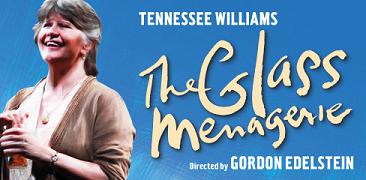
REMEMBERING TOM
If revivals are to be the mainstay of our national theater – thereby turning our theaters into museums – then interpretative artists are going to have to find ways to guarantee that theater continues to be a living, breathing organism. One way is to rediscover the elements that define a classic and unify them into a cohesive and stylish piece of theater that allows new audiences to understand why that particular play is great and reminds those of us – who have sat through more productions of that particular classic than one is willing to count – why we loved it enough in the first place to keep coming back again and again. An even better way – because it satisfies both camps – is for a director to look for something in that classic that has never been looked at before and to bring that something to life in a way that not only confirms the greatness of that classic, but actually makes its audience see the work with fresh eyes, as if, indeed, it has never seen the play before.
Far too often, plays are revived merely as vehicles for stars or because actors like to bite into the kind of juicy roles those plays contain; these productions might provide some entertainment value, but they often serve to stop a play dead in its tracks. There is nothing new or fresh there; sometimes it can even be painfully dull. Sure, every great actor wants to play  Hamlet, but even Hamlet, the play, needs more than just a actor’s interpretation to maintain not only our interest but our avid curiosity about the myriad mysteries of the poetic magic that has kept the play alive for centuries. Some plays even risk being diminished with time as a result of uninspired interpretation: I am thinking now of a recent Broadway production of Harold Pinter’s
Hamlet, but even Hamlet, the play, needs more than just a actor’s interpretation to maintain not only our interest but our avid curiosity about the myriad mysteries of the poetic magic that has kept the play alive for centuries. Some plays even risk being diminished with time as a result of uninspired interpretation: I am thinking now of a recent Broadway production of Harold Pinter’s 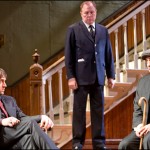 The Homecoming which domesticated the play to such an extent that a great work of art was transformed into a soap opera, its more forbidding revelations coarsened and vulgarized; or, for that matter, most productions of Samuel Beckett’s
The Homecoming which domesticated the play to such an extent that a great work of art was transformed into a soap opera, its more forbidding revelations coarsened and vulgarized; or, for that matter, most productions of Samuel Beckett’s 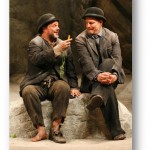 Waiting For Godot, which insist upon its vaudeville-inspired antics to the exclusion of its powerful portrait of futility and despair, turning a seminal work of contemporary theater into a crowd-pleasing comedy. Pinter and Beckett will survive, one suspects, but, in the meantime, they are desperately in search of someone willing to take today’s audiences to deeper and darker places and permit them to see what two of our greatest playwrights were really getting at.
Waiting For Godot, which insist upon its vaudeville-inspired antics to the exclusion of its powerful portrait of futility and despair, turning a seminal work of contemporary theater into a crowd-pleasing comedy. Pinter and Beckett will survive, one suspects, but, in the meantime, they are desperately in search of someone willing to take today’s audiences to deeper and darker places and permit them to see what two of our greatest playwrights were really getting at.
As for the productions that remind one of a play’s classic status, there are many but not nearly enough examples, but they would include the justly famous Chichester production of Anton Chekhov’s Uncle Vanya or the recent production from London’s Royal Court Theater of  The Seagull (Chekhov, though he can be seriously misunderstood, seems to have the best record, among classic playwrights, for staying the course through time), or most of the revivals of plays by
The Seagull (Chekhov, though he can be seriously misunderstood, seems to have the best record, among classic playwrights, for staying the course through time), or most of the revivals of plays by 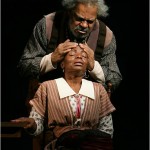 August Wilson, which seem intensely dedicated to proving that he is one of our most innovative and most singular artists, or all the works that Bartlett Sher, in recent years, has turned his authoritative directorial eye upon (Richard Rodgers and Oscar Hammerstein II’s South Pacific, Clifford Odets’s Awake and Sing and Wilson’s Joe Turner’s Come and Gone).
August Wilson, which seem intensely dedicated to proving that he is one of our most innovative and most singular artists, or all the works that Bartlett Sher, in recent years, has turned his authoritative directorial eye upon (Richard Rodgers and Oscar Hammerstein II’s South Pacific, Clifford Odets’s Awake and Sing and Wilson’s Joe Turner’s Come and Gone).
But the most exciting and illuminating revivals are the ones that demand that we see the plays as if we were experiencing them for the very first time. Among those are the  Andrei Serban productions of the four Chekhov plays, but most especially The Cherry Orchard and The Seagull, which were eye-opening in terms of character and yet absolutely spot-on; the Cheek by Jowl’s glorious all-male production of Shakespeare’s As You Like It, which turned all that play’s gender-bending upside down; Joseph Chaikin’s pared-down but grandly tragic version of Sophocles’s Elektra; Peter Brook’s wintry concept of King Lear; the simple but still revolutionary approach
Andrei Serban productions of the four Chekhov plays, but most especially The Cherry Orchard and The Seagull, which were eye-opening in terms of character and yet absolutely spot-on; the Cheek by Jowl’s glorious all-male production of Shakespeare’s As You Like It, which turned all that play’s gender-bending upside down; Joseph Chaikin’s pared-down but grandly tragic version of Sophocles’s Elektra; Peter Brook’s wintry concept of King Lear; the simple but still revolutionary approach  David Cromer brought to Thornton Wilder’s Our Town, making it breathe again in ways which had been stifled by too many tired and mundane productions over the years (both professional and amateur), and the way the same David Cromer turned the jokes in Neil Simon’s Brighton Beach Memoirs inside out and revealed that, within Simon’s comic breast, there was a Chekhov bursting to get out, that the tragic plight of a poor Jewish family in Brooklyn during the depression was made bearable by an ability on the part of its characters to crack wise when desperation started crowding in on them; the glorious second act of the recent badly-maligned revival of Tennessee Williams’s
David Cromer brought to Thornton Wilder’s Our Town, making it breathe again in ways which had been stifled by too many tired and mundane productions over the years (both professional and amateur), and the way the same David Cromer turned the jokes in Neil Simon’s Brighton Beach Memoirs inside out and revealed that, within Simon’s comic breast, there was a Chekhov bursting to get out, that the tragic plight of a poor Jewish family in Brooklyn during the depression was made bearable by an ability on the part of its characters to crack wise when desperation started crowding in on them; the glorious second act of the recent badly-maligned revival of Tennessee Williams’s 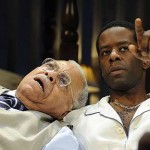 Cat On A Hot Tin Roof – with an African-American cast – which was played, as Williams always insisted it should be played, as a love scene in which Big Daddy is more insightful about Brick’s relation to his dead friend than Brick is, because he knew, through personal experience, the real nature of the homosexuals whose plantation he – a hired hand – inherited, suggesting that, perhaps, Big Daddy himself was connected to them in more complex ways than anyone could have guessed.
Cat On A Hot Tin Roof – with an African-American cast – which was played, as Williams always insisted it should be played, as a love scene in which Big Daddy is more insightful about Brick’s relation to his dead friend than Brick is, because he knew, through personal experience, the real nature of the homosexuals whose plantation he – a hired hand – inherited, suggesting that, perhaps, Big Daddy himself was connected to them in more complex ways than anyone could have guessed.
Williams is indeed ripe for re-interpretation; the era in which he wrote was not as liberated as he was or, rather, Williams had to hide behind metaphor because of the times and because his greatest interpreter, Elia Kazan, was so adamantly heterosexual.
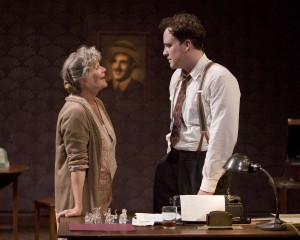 Which brings us finally to Gordon Edelstein’s fierce, funny, passionate, haunted examination of The Glass Menagerie, which stands magnificently among the most remarkable examples of an old play given brand new life.
Which brings us finally to Gordon Edelstein’s fierce, funny, passionate, haunted examination of The Glass Menagerie, which stands magnificently among the most remarkable examples of an old play given brand new life.
What Edelstein has done is to recognize that the most important character in any “memory” play is the playwright himself, even if the other characters in the play are better written or more insightfully examined. In the recent revival of Eugene O’Neill’s Long Day’s Journey Into Night with the great Vanessa Redgrave as Mary Tyrone, the relationship between Mary and her son, O’Neill’s alter-ego Edmund, for example, was stressed to a degree that the play itself finally came into proper focus as a play about a playwright and his love for his mother, rather than as a play about the conflict between a miserly father and his alcoholic son.
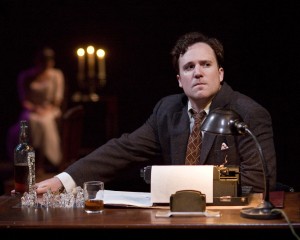 In the first few gorgeous moments of Edelstein’s vision – on Michael Yeargan’s purposely drab setting, which possibly represents all the grim hotel rooms Williams occupied once he left St. Louis for New Orleans – an older, clearly gay Tom, on the road to alcoholism, tries to get those absolutely perfect words down on paper that open the play we know as The Glass Menagerie. Patch Darragh, in a career-transforming performance, makes an all-too-real Tom, rumpled and weary and soft and extremely hard on himself. As the words finally come out of him and run through his fingers onto the typewriter, we see visualized the process by which an artist brings creatively to life the painful pictures of his past and what has brought him to this state. Once this Tom has been established, the rest of the play comes at us, not as the play we have seen before, but as a startlingly revelatory new play. And Tom is always at the center. Even Amanda Wingfield – one of the best-known creations in all of dramatic literature – becomes, under this kind of scrutiny, merely a creature formed by Tom’s imagination.
In the first few gorgeous moments of Edelstein’s vision – on Michael Yeargan’s purposely drab setting, which possibly represents all the grim hotel rooms Williams occupied once he left St. Louis for New Orleans – an older, clearly gay Tom, on the road to alcoholism, tries to get those absolutely perfect words down on paper that open the play we know as The Glass Menagerie. Patch Darragh, in a career-transforming performance, makes an all-too-real Tom, rumpled and weary and soft and extremely hard on himself. As the words finally come out of him and run through his fingers onto the typewriter, we see visualized the process by which an artist brings creatively to life the painful pictures of his past and what has brought him to this state. Once this Tom has been established, the rest of the play comes at us, not as the play we have seen before, but as a startlingly revelatory new play. And Tom is always at the center. Even Amanda Wingfield – one of the best-known creations in all of dramatic literature – becomes, under this kind of scrutiny, merely a creature formed by Tom’s imagination.
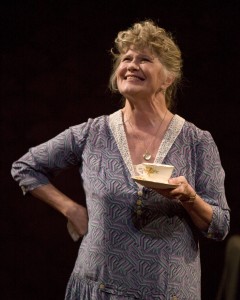 That is a blessing. As someone who has seen more productions of this play than perhaps any other play – possibly because I kept hoping against hope that I would understand why a play that read so beautifully always played so poorly – I have come to believe Williams, who claimed that, without Laurette Taylor’s Amanda, the play would have been a “succes d’estime” rather than the hit it became – I was always struck by the fact that, on the stage, Amanda seemed such an unpleasant shrew, regardless of how good the actress playing the part was. But with the focus on Tom, Judith Ivey’s Amanda has room to bring as many colors to the part as there are in the human spectrum, and, because she can do that, her last words, cruel and ugly, really make us understand why Tom finally had to leave her behind, leaving, as well, the sister he loves , Laura, and why those words – “Go to the movies, go!….Go, then! Go to the moon – you selfish dreamer!” – resonate with such intensity inside Tom’s soul and in our hearts.
That is a blessing. As someone who has seen more productions of this play than perhaps any other play – possibly because I kept hoping against hope that I would understand why a play that read so beautifully always played so poorly – I have come to believe Williams, who claimed that, without Laurette Taylor’s Amanda, the play would have been a “succes d’estime” rather than the hit it became – I was always struck by the fact that, on the stage, Amanda seemed such an unpleasant shrew, regardless of how good the actress playing the part was. But with the focus on Tom, Judith Ivey’s Amanda has room to bring as many colors to the part as there are in the human spectrum, and, because she can do that, her last words, cruel and ugly, really make us understand why Tom finally had to leave her behind, leaving, as well, the sister he loves , Laura, and why those words – “Go to the movies, go!….Go, then! Go to the moon – you selfish dreamer!” – resonate with such intensity inside Tom’s soul and in our hearts.
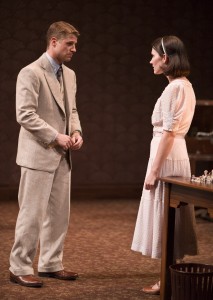 It is evident, now more than ever, that it’s not the movies Tom is always going to. And that the “magic scarf” he gets from Malvolio the Magician is really something he has taken from a pick-up. It is even possible, in this fresh interpretation, that The Gentleman Caller is someone Tom himself is attracted to. In reading between the lines, Edelstein and his actors come up with new meanings that deepen and enrich the play.
It is evident, now more than ever, that it’s not the movies Tom is always going to. And that the “magic scarf” he gets from Malvolio the Magician is really something he has taken from a pick-up. It is even possible, in this fresh interpretation, that The Gentleman Caller is someone Tom himself is attracted to. In reading between the lines, Edelstein and his actors come up with new meanings that deepen and enrich the play.
Since Tom has forgotten to pay the electricity bill, the lights go out right in the middle of dinner with the Gentleman Caller, and the great scene between Laura, who fights against her lameness by de-emphasizing the limp, and Jim, the gentleman caller, is played by candlelight, which, while sometimes difficult to see, creates a kind of magic.  Keira Keeley’s Laura is lovely. Ben McKenzie’s Jim seems a bit misguided – there is more tentativeness here than brashness – but the production is so rich that, in retrospect, his performance has a way of lingering in one’s memory.
Keira Keeley’s Laura is lovely. Ben McKenzie’s Jim seems a bit misguided – there is more tentativeness here than brashness – but the production is so rich that, in retrospect, his performance has a way of lingering in one’s memory.
The Glass Menagerie has been waiting for precisely this kind of clear-eyed and compassionate investigation, and anyone who claims to love Tennessee Williams should rejoice that it has arrived.
harveyperr @ stageandcinema.com
photos by Craig Schwartz
scheduled to close October 17 at time of publication
for tickets, visit http://www.centertheatregroup.org/tickets/productiondetail.aspx?id=11440
